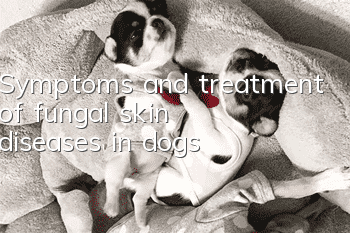Symptoms and treatment of fungal skin diseases in dogs

Fungal skin disease is caused by fungal infection and is a common skin disease in dogs. Owners are advised to do more daily observation to avoid not knowing that the dog is sick. So what are the symptoms of fungal skin disease in dogs and how to treat it?
Vishla Hound
1. Causes of canine fungal skin diseases:
1. The occurrence of skin mycosis in dogs has a certain relationship with climate, age and physical constitution. For example, the incidence rate is higher in hot and humid climates, and young animals are more susceptible than adult animals. Those with malnutrition and weak constitution are more susceptible than those with strong nutritional constitution.
2. In clinical practice, when the long-term application of large-dose stimulation causes the dog's resistance to decrease, it is also susceptible to the disease.
3. Pathogens According to clinical statistics, 5 kinds of molds have been found to cause skin mycosis in dogs. They are: Microsporum canis, Microsporum gypseum, Trichophyton mentagrophytes, Microsporum audouinii and Microsporum mutans. spores. Among them, Microsporum canis is the most common, followed by Microsporum gypseum, Trichophyton mentagrophytes and Microsporum audouinii. Microsporum proteus is only found in a few countries, such as Australia, and its incidence is low.
2. Clinical symptoms of canine fungal skin disease:
1. Microsporum canis:
Found all over the world, more than 70% of canine ringworm cases are caused by it. A variety of animals and people can be infected. The main lesions are small round-like scabs (ringworm) formed on the skin surface. This kind of localized scab skin lesions can appear on any part of the dog, but the ears, face, neck and tail are the most common. This type of lesions, which are mainly skin scabs, are often not accompanied by hair loss. When there are not many lesions, especially when they occur in long-haired dogs, they are often not discovered. Microsporum canis mainly causes tinea capitis in humans.
2. Microsporum gypsum:
Living in soil all over the world, it can cause skin mycosis in dogs and other animals and humans. The onset of this disease is rapid and the damage is severe. The site of occurrence is similar to that of Microsporum. In addition to round pimples, it sometimes causes large-area skin lesions. The coat of the lesion falls off, and dandruff and scabs appear. When secondary bacterial infection occurs, exudative suppuration occurs locally. It can last for months or even years after it becomes chronic.
3. Microsporum auduanii and Trichophyton mentagrophytes:
Canine skin mycosis caused by these two bacteria is rare. These two molds can also infect people. The former mainly causes tinea capitis in children, and the latter is the main pathogen of athlete's foot in the United States. Dogs usually become infected through contact with sick people.
3. Popular characteristics of canine fungal skin diseases:
1. Mold has extremely strong vitality and resistance. It can parasitize animals and plants or travel with dust.Angstroms are dispersed in the air and have many opportunities for spread.
2. Skin mold enters the skin through scratches.
3. Infection is mainly through direct contact, but indirect infection can also be caused by contact with contaminated utensils, combs, scissors, mats, etc.
4. Animals and humans and dogs can be infected with each other.
4. Prevention and treatment measures for canine fungal skin diseases:
1. Some skin mycoses tend to be self-limiting diseases. Although they are not treated, they can recover on their own.
2. Early-stage sick dogs that are treated in time can be effective only by local treatment with external drugs, but chronic and severe skin mycosis must be treated with oral drugs at the same time.
3. External drug therapy: first wash off the dandruff and scabs, clean the shed and broken coat, and then apply one of the following ointments: clotrimazole ointment, compound salicylic acid ointment, miconazole ointment or 11 Dilute acid ointment can also be used, and other effective patent medicines can also be used, such as tinea net, etc. 1-2 times a day until completely healed.
4. Oral drug therapy: Flavomycin is the drug of choice. The daily dosage is 20 to 40 mg per kilogram of body weight. Take it orally once or in 2 times for 4 to 8 weeks. Mix this medicine with fatty food to promote absorption. It is prohibited for pregnant dogs to avoid causing fetal malformations. Another oral drug is ketoconazole, 10 mg/kg of body weight per day, taken orally three times for 2 to 8 weeks. This medicine is irritating to the stomach, and some dogs may develop allergic reactions such as itching. If the reaction is severe, you should stop taking it and switch to another drug.
5. There are no special preventive measures for skin mycosis. General epidemic prevention work should be carried out. Detect sick dogs early and isolate and treat them promptly. At the same time, pay attention to strengthening nutrition and good management. The feed should contain enough protein, and attention should be paid to supplementing various vitamins, minerals and trace rare elements to enhance the body's resistance. Pay attention to grooming the coat, keeping it clean and preventing scratches.
6. Pay attention to public health and prevent the spread of the disease from dogs to humans and from humans to dogs. Various skin mycoses in dogs can infect people, especially children who are most susceptible to molds. They often cause tinea capitis and tinea capitis due to contact with sick dogs. Dog families should pay attention to this. At the same time, care should be taken not to infect the owner's ringworm to the dog.
- Treatment methods for dog vomiting and diarrhea
- Will dogs rupture their intestines if they eat dried duck neck?
- Is the Great Gryffindor easy to raise? How to raise it?
- Is the Basset Dog easy to raise? Basset Dog_Price_Training
- What causes pyoderma in dogs?
- What should I do if my dog takes deworming medicine after vaccination?
- Introduction to Inabao and other dog foods
- What should I do if my Husky puppy barks at night?
- How to give dogs the best calcium supplement
- Are Alaskan Malamutes easy to raise? How to raise



